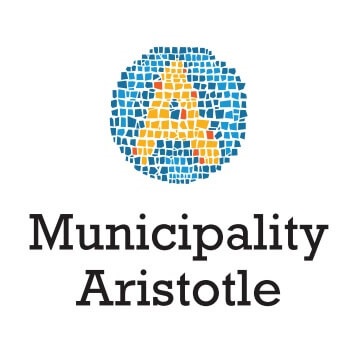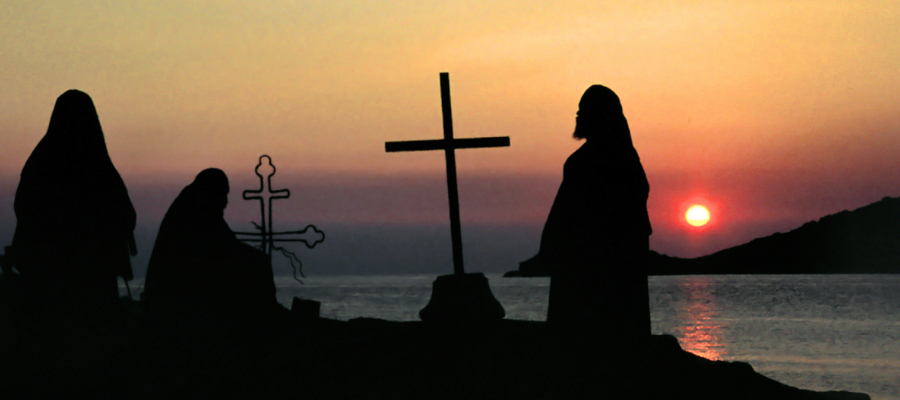The term Athos, known to all of us as Mount Athos, has been the most important center of Orthodox monasticism since the late 10th century and is considered one of the greatest monuments of the world’s cultural heritage. It occupies the northernmost projection of the Chalkidiki peninsula, with a length of 45 km and a width of 5-10 km, and takes its name from the eponymous peak (2,033 m) of the mountain that dominates this rocky strip of land.
The Athonian peninsula is forested, has pastures, and small plots of land that the monks have been cultivating for centuries, practicing their “handwork”. However, popular belief refers to it as the “Garden of the Virgin,” since only She retains the privilege of having it as Her own land and territory. Although tradition suggests that the first hermits settled on the uninhabited Athos around the late 8th century, the first to be mentioned are Peter the Athonite, a figure shrouded in myth, and Saint Euphemius the New, who arrived in 859. The initial appearance of coenobitic monasticism on Athos is attested in 963, when Athanasius the Athonite, with the support of his friend Emperor Nicephorus Phocas, founded the oldest monastery, the Great Lavra. In 972, John Tzimiskes signed the famous “Charter” on parchment, which constitutes the first “typikon” of Athonite monasticism, with the rules for the organization and functioning of the coenobiums.
Among the most ancient and inviolable rules is the “Athonite prohibition.” Emperor Constantine Monomachus established in 1060 the prohibition of eunuchs, beardless boys, and any woman from entering Mount Athos. From its early years, it attracted the interest, favor, protection, and tax immunity of the Byzantine emperors and other Orthodox rulers. At the same time, the Ecumenical Patriarchate of Constantinople claimed and still maintains its spiritual jurisdiction over the monasteries.
COENOBITIC ORGANIZATION
Since the 10th century, Mount Athos has attracted monks from various Orthodox countries. The Georgian monastery of Iviron was founded in 979-80, and later, the Italian monastery of the Amalfi, which no longer exists, was established. Several Orthodox Armenians were included in the brotherhood of the Monastery of Esfigmenou. From the 12th century, Slavic monks arrived. The Monastery of Panteleimonos passed into the hands of monks from the land of the Rus, around Kyiv. The Monastery of Hilandar was renovated as a Serbian monastery, while in the 13th century, the Monastery of Zografou housed Bulgarian monks. Mount Athos has maintained a consistent Orthodox character throughout the ages.
The coenobitic organization of the monastic brotherhoods quickly gained ground over the solitary hermits. The administration and spiritual guidance were carried out by the abbot, while the duties were a responsibility for each monk, and the meals were communal. The Lavra, Vatopedi, and Iviron monasteries occupied the first positions in the hierarchical ranking of the monasteries and had priority in the central administration of Mount Athos, the Protaton of Karyes. In the 11th-12th centuries, new monasteries such as the Monasteries of Konstamonitou, Docheiariou, and Koutloumousiou were established, while others expanded their holdings.
ARCHITECTURE
Over the centuries, the monasteries’ architecture has been shaped into large multi-story enclosed buildings, with wings that include not only the monks’ cells but also installations that ensure their self-sufficiency. The refectory, where the monks and pilgrims gather for their meals, the storehouse where food and oil are stored, along with the wine cellar, are some of the numerous buildings in the monasteries. In the central courtyard is the sacred church, the Katholikon, which is the center of monastic life. Also in the courtyard is the font, a fountain used for the blessing of the waters. The monastery has its own arsanas, which is a building complex on the shore, equipped with a dock and storage areas.
The constant threat from various invaders throughout history forced the monasteries to develop impressive fortifications, with towering defensive towers dominating the space. The capture of Constantinople in 1204 by the Crusaders of the Fourth Crusade and the subjugation of Mount Athos to the Latin Kingdom of Thessalonica created many problems. Additionally, pirate attacks on the monasteries at the beginning of the 14th century by the infamous Catalan Company strained the relationship of the Athonites with the Latins. The history of the monasteries during that time also records the pirate raids of the Turkish emirs of Asia Minor. A period of prosperity followed with the founding of the monasteries of Gregory, Dionysius, Pantokrator, and Simonopetra. During that time, Mount Athos became the center of the Hesychast movement, with representative figures such as Gregory Palamas, who expressed the mystical dimension of the Orthodox tradition.
MONASTIC PROPERTY
The property of the Athonite monasteries included estates, vineyards, pastures, mills, fish farms, entire villages, urban rental properties, and workshops. These properties were spread across Macedonia, including Thessalonica, particularly on the Chalkidiki peninsula and the Strymonas Valley. They also extended to Thrace, Lemnos, Serbia, and Wallachia. Several monasteries owned ships for transporting goods and importing necessary supplies.
Imperial chrysobulls guaranteed their property rights and tax exemptions, and their benefactors included not only humble peasants but also Byzantine emperors, the Great Komnenoi of Trebizond, rulers of Serbia and Bulgaria, and the voivodes of Wallachia.
In the 14th century, the peculiar form of monasticism developed, with the monasteries being governed by a synod of elders. Worship was communal, but the duties were remunerated. Each monk was responsible for covering his personal needs. Today, all the monasteries follow the coenobitic way of life.
SKITES, CELLS, AND CHAINS
With the consolidation of Ottoman rule over Mount Athos in 1430, its autonomy was recognized, and the monasteries became tax-exempt. During the Ottoman period, some peculiar forms of monastic exercise spread and still exist today, such as Sketes, Cells, Seatings, and Hermitages. These fall under the authority of a specific monastery as “dependencies” of it.
- Sketes are settlements consisting of “huts” built around a church called “Kyriako.” Each “hut” is inhabited by three monks who elect a superior for the Skete, called the “Dikaios.” The oldest Sketes on Mount Athos are those of Agia Anna and Kafsokalivia.
- Cells consist of a small church and a dwelling with its own small garden. They are granted for life to an elder monk who practices asceticism there with his “disciples,” usually two “novices.”
- Seatings and Hermitages are solitary huts on the rugged southwestern coasts of Athos, where the hermit practices strict asceticism with constant prayer, vigil, and fasting.
The Ottoman era brought forth significant personalities in Mount Athos, such as the Cretan Agapios Landos and the Kollyvades in the 18th century. Meanwhile, in 1848, the Monastery of Vatopedi established a core of the modern Greek Enlightenment, the “Athoniada,” with famous students such as Iosipos Moisiodakas and Kosmas the Aetolian. In May 1821, Emmanouil Papas landed at Daphne and proclaimed the Revolution. A new period began with the liberation of Macedonia when international conditions recognized the self-governing status of the Holy Mountain within the boundaries of the Greek state. Today, the Treaties of the European Union ensure the inviolability of the ancient regime that has always prevailed in the Athonite peninsula.
RECOVERY
In modern times, Athonite monasticism has shown an optimistic recovery, overcoming a period of decline when depopulation ravaged the enormous monastic complexes. In the last thirty years, the number of new monks has more than doubled, and the monasteries have been renovated. Monasticism has gained especially qualitative characteristics, with the reinforcement of the coenobitic way of life. Elder Athonite fathers, with impressive spiritual and moral stature, have led many educated young people to the monastic tonsure.
Today, the 20 “Sovereign,” “Royal,” “Patriarchal,” and “Stavropegic” holy monasteries, which form the Monastic Republic of Mount Athos, continue to spiritually support the Church and Greek society with their ascetic lifestyle, while fighting hard to preserve the unique divine-human Athonite landscape.
Text: Dr. Antonios G. Dikaios / Theologian – Environmentalist



